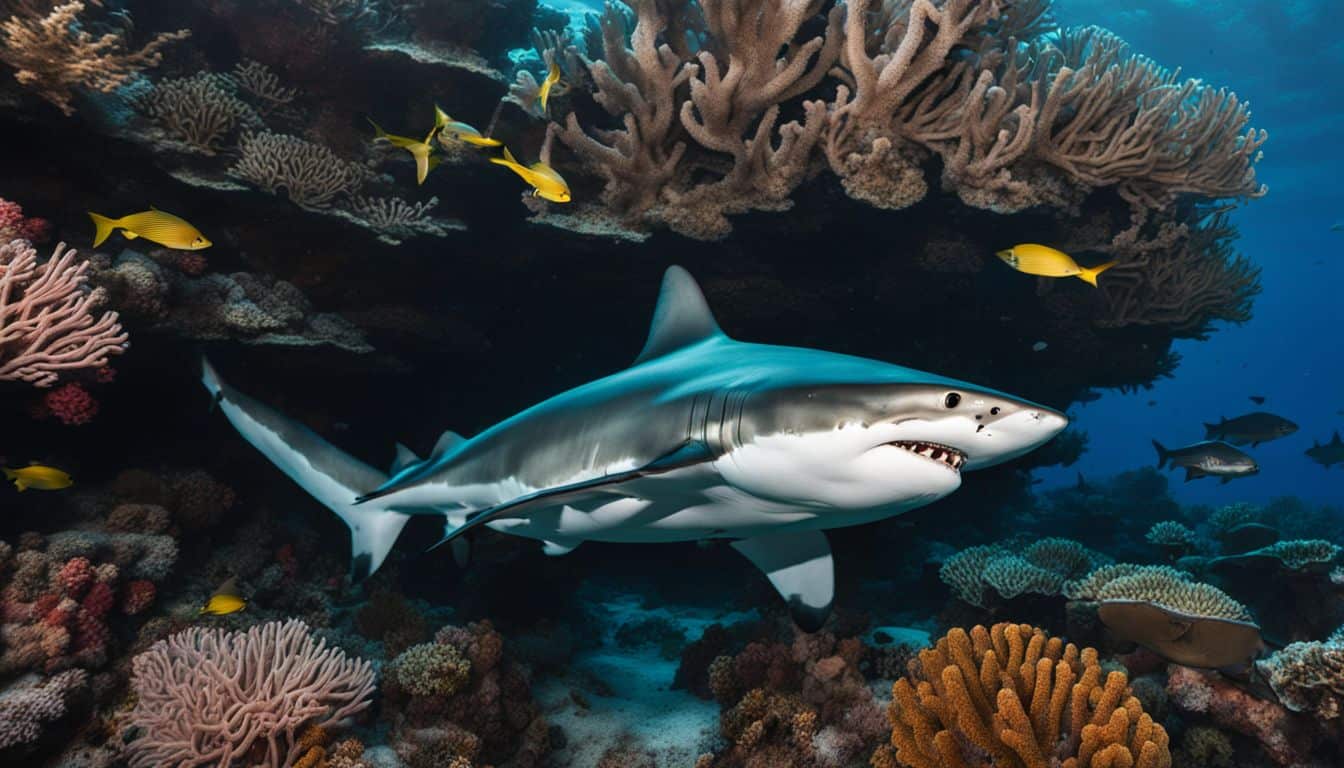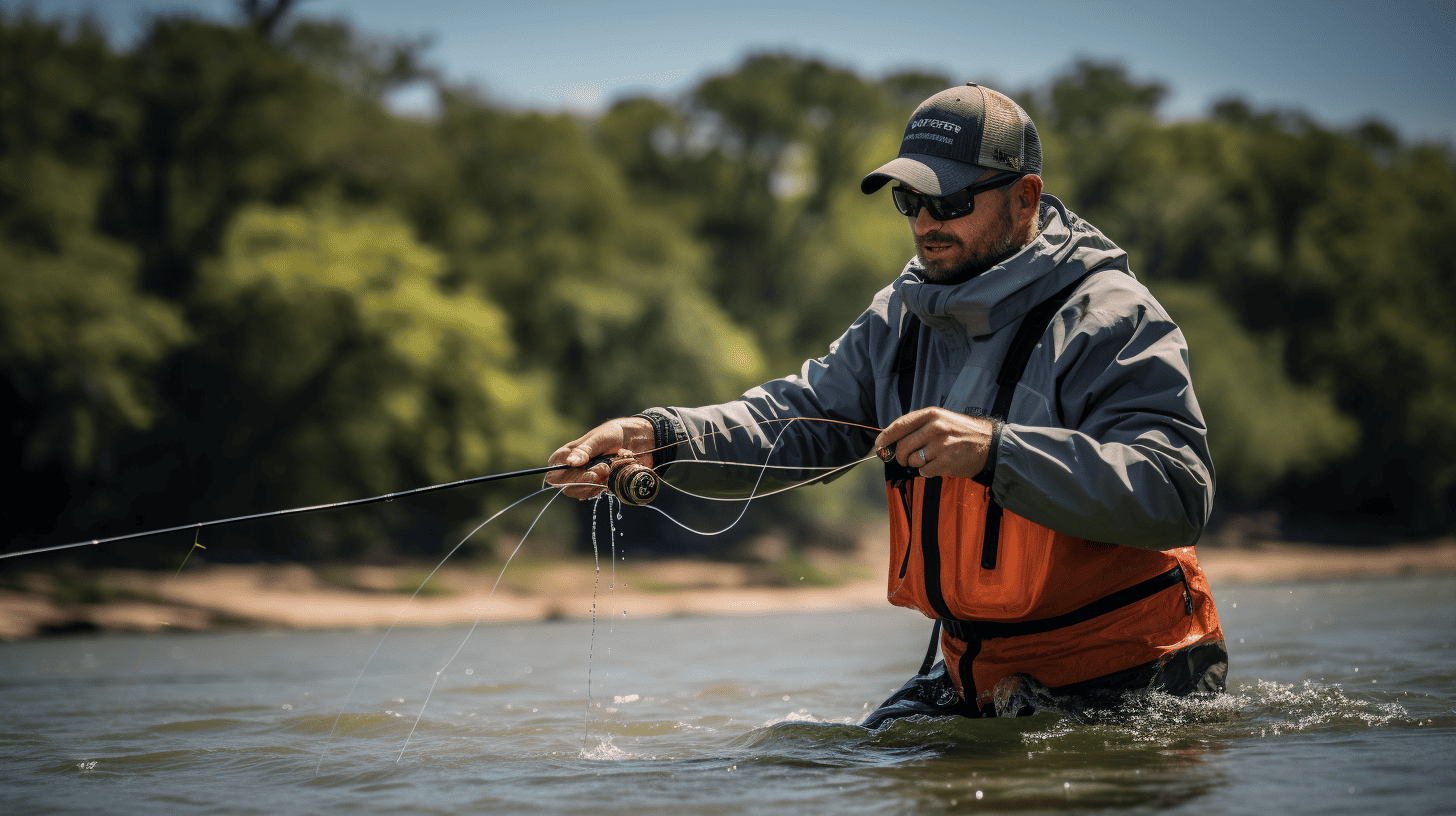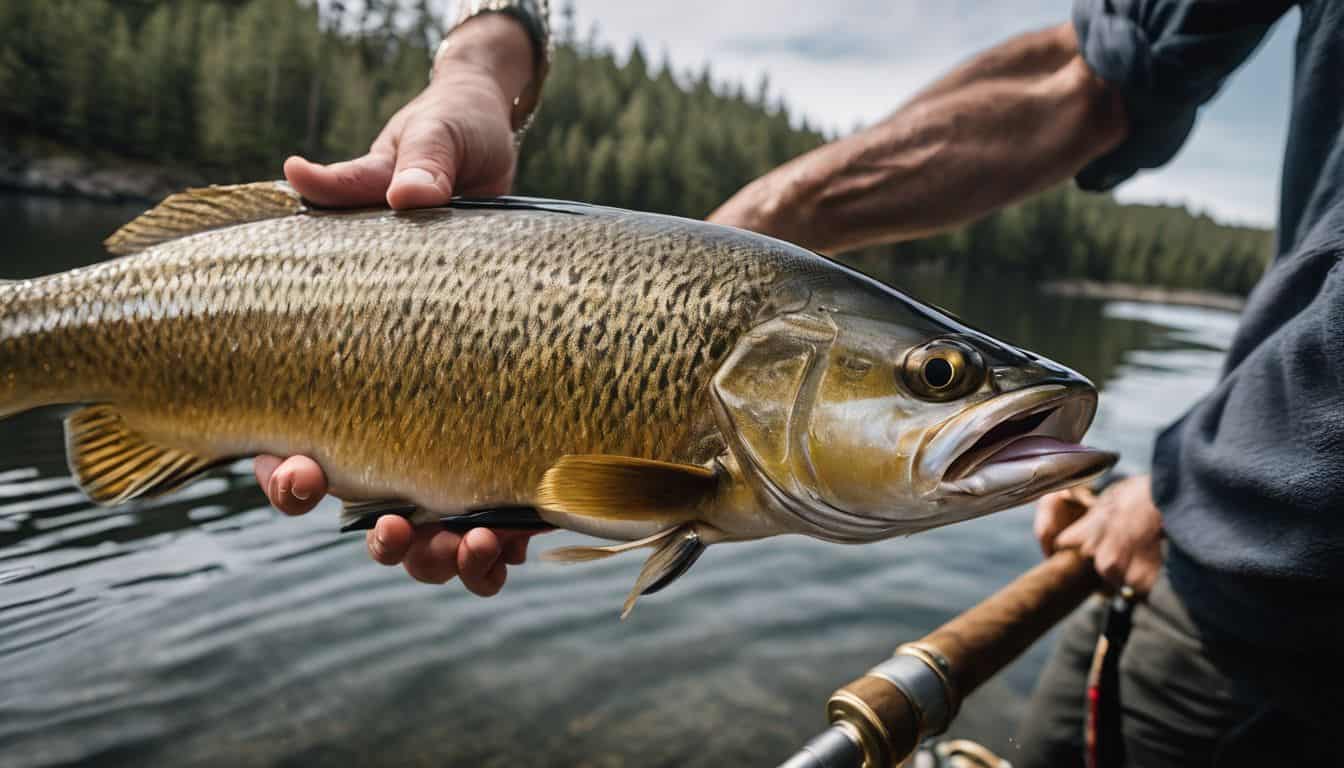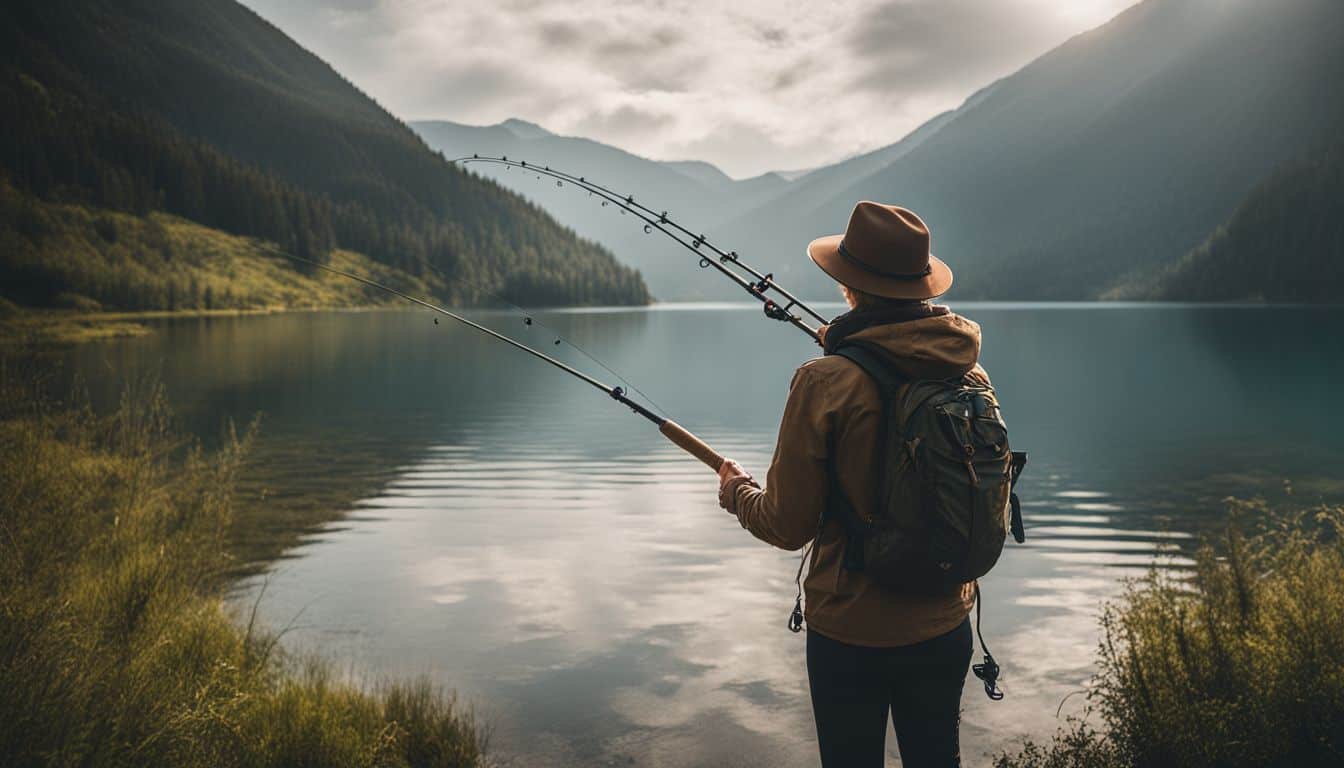Are you a fishing aficionado who’s weary of returning home with nothing to show for your efforts? Boy, do I resonate with that sentiment. The secret sauce lies in deciphering the enigmatic behavior of fish and adapting our bait strategy to suit their preferences.
Drawing from extensive research and good ol’ hands-on experience, this blog post will arm you with 21 foolproof tips that can help you better navigate these underwater conundrums. Have we piqued your curiosity yet? Well then, let’s take the plunge!
Key Takeaways
- Understanding fish behavior is important for fishing success as it helps us know when and where to find them.
- Factors like habitat, food supply, temperature, and water quality influence fish behavior.
- Fish exhibit different feeding behaviors like predatory hunting, filter – feeding, and scavenging, which impact their patterns and habits.
- Knowing the reproductive cycle of fish species and recognizing signs of spawning behavior can enhance fishing success.
- Fish migration and movement patterns are influenced by changing seasons, affecting their catchability for anglers.
The Importance of Understanding Fish Behavior
Understanding fish behavior is crucial for fishing success. The way fish behave and their patterns are influenced by various factors such as habitat, food supply, temperature, and more.
As anglers, knowing how these factors affect fish behavior can greatly improve our chances of catching fish.
How fish behavior affects fishing success
Fish act in ways that help them live well. They look for food, stay safe from danger, and make little fish. As a person who fishes, I need to know about these things. If I know when and where fish look for food, I can put my bait there.
The same goes for understanding when they are at rest or trying to keep out of sight from predators. It even helps to know about how fish talk with one another! All this knowledge means more luck catching fish on the end of my line!
Factors influencing fish behavior (habitat, food supply, temperature, etc.)
Fish behavior relies on plenty of things. Here are a few key factors:
- Habitat: Fish pick their homes based on protection, food, and room to grow. They like places with lots of food and safety from bigger fish.
- Food Supply: Fish go where the food is. It’s that simple.
- Temperature: Cold-blooded creatures, fish rely on the water temperature for body heat. Some prefer warm waters while others choose cooler areas.
- Water Quality: Clean water helps fish breathe and find food easier. Dirty water is hard for them to live in.
- Elevation: The height of the water source affects fish too. Some adapt to high mountain streams while others thrive in low-lying coastal waters.
- Physical Habitat: Rocks, plants, and sand all play a part in attracting certain kinds of fish.
- Time of Day: Some fish are more active during daylight hours, while others come out at night.
Feeding Patterns and Habits
Fish exhibit a variety of feeding behaviors, such as predatory hunting, filter-feeding, and scavenging, which can greatly impact their patterns and habits.
Types of feeding behaviors (predatory, filter-feeding, scavenging, etc.)
Understanding fish feeding behaviors is a crucial part of understanding their overall behavior and patterns. These behaviors can range from predatory feeding, filter-feeding, scavenging, to other mechanisms such as fluid feeding and deposit feeding.
| Type of Feeding Behavior | Description |
|---|---|
| Predatory Feeding | This behavior refers to fish actively hunting and capturing their prey. It’s a common behavior among many fish species. |
| Filter-Feeding | Filter-feeding is a strategy where fish filter and consume small particles from the water. It’s a way for fish to obtain nutrients without actively hunting. |
| Scavenging | Scavenging involves consuming dead or decaying organic matter. It’s a way for fish to find food without the difficulty of catching live prey. |
| Deposit Feeding | In deposit feeding, fish consume organic matter from sediments or substrates. It’s a great way for fish to find nutrients in the deeper parts of their habitats. |
| Fluid Feeding | Fluid feeding involves consuming the fluids of other organisms. Some fish have evolved this mechanism to adapt to their ecological niches and prey. |
Each of these feeding behaviors indicates the fish’s strategies for survival and provides insights into their ecological roles and preferences in their habitats. As an angler, understanding these behaviors can be crucial in predicting fish movements, pinpointing feeding times, and ultimately, achieving fishing success.
Understanding feeding preferences and timing
Feeding preferences and timing play a crucial role in fish behavior and growth. Here are some important tips to help you understand and utilize this knowledge:
- Fish have different dietary preferences based on their species, size, and habitat.
- Some fish are carnivorous, feeding on other smaller fish or invertebrates, while others are herbivorous, consuming plants or algae.
- The time of day can affect feeding behavior, with some fish being more active during dawn or dusk.
- Water temperature also influences feeding patterns, as warmer waters tend to increase the metabolism of fish and their desire to feed.
- Understanding what types of bait or lures closely resemble the natural prey of your target fish can greatly improve your chances of success.
- Monitoring the movement and behavior of nearby birds and other wildlife can provide clues about where the fish may be actively feeding.
- Experimenting with different depths and locations can help you determine where the fish are most likely to be hunting for food.
- Pay attention to changes in weather conditions, such as rain or wind, as they can affect the availability and movement of prey that attract feeding fish.
- Keep in mind that some species have specific feeding habits, such as bottom-dwelling fish known for scavenging on the ocean floor or surface-feeding predators that rely on insects and small animals near the water’s surface.
- Patience is key when observing feeding patterns. Sometimes it takes time for fish to become comfortable enough to feed in a new area.
Reproduction and Spawning Behavior
Understanding the reproductive cycle of fish species and recognizing signs of spawning behavior is crucial for anglers seeking to enhance their fishing success.
Understanding the reproductive cycle of fish species
Fish reproduction is an important aspect of understanding their behavior. Fish have reproductive organs called gonads, which can be either testes or ovaries. These organs are responsible for producing eggs and sperm.
In some fish species, the gonads may be partially or totally fused together. Understanding fish reproductive biology is crucial for managing fisheries and ensuring sustainable populations.
Fish go through an annual reproductive cycle, which involves changes in both males and females. Proper breeding behavior and spawning are essential for successful reproduction. The timing of reproduction in marine fishes can vary depending on environmental factors such as temperature and food availability.
Recognizing signs of spawning behavior
When it comes to studying fish reproduction, recognizing signs of spawning behavior is crucial. By observing the behavior of fish, we can gather important information about their breeding patterns.
For example, male fish may chase and nudge females in shallow areas during the mating ritual. Evaluating when this behavior occurs and where it takes place can provide insights into a species’ reproductive timing and help assess its overall success in reproducing.
Analyzing factors like gonadal development, ovulation frequency, and parental care can also contribute to our understanding of fish reproduction dynamics. So paying close attention to these signs allows us to learn more about how fish reproduce.
Migration and Movement Patterns
Fish migration and movement patterns are influenced by changing seasons, which can have a significant impact on fishing success.
Seasonal migrations and their impact on fishing
Fish migrations are a natural behavior that many fish species engage in. During certain times of the year, fish will move from their breeding grounds to their feeding grounds and vice versa.
This movement can have a big impact on fishing. When fish migrate, they may change their behavior and patterns, making them more or less likely to bite your bait. Understanding these migration patterns can help you become a more successful angler.
For example, during certain times of the year, freshwater fish may migrate to find better food sources or avoid predators. This means that if you’re fishing in an area where there is usually a lot of fish activity, but suddenly there are fewer bites, it might be because the fish have migrated elsewhere.
Knowing when and where these migrations occur can give you valuable information about where to cast your line.
It’s also important to note that when fish migrate, older individuals often make up a larger proportion of the population. This can influence which types of fish are caught by anglers and affect the selectivity of fisheries.
By understanding these migration patterns and how they impact fishing, you can increase your chances of having a successful day on the water.

Tracking fish movement for better angling success
Tracking fish movement is crucial for improving your angling success. By understanding where fish are moving, you can position yourself in the right spot at the right time. Here are some tips to help you track fish movement:
- Use tracking devices: Researchers have been using tracking devices for years to monitor fish movements and growth. These devices provide valuable data about where fish go and when.
- Study migration patterns: Fish migration involves the mass relocation of fish from one area or body of water to another. By studying migration patterns, you can predict when and where certain fish species will be present.
- Monitor navigation and passage patterns: Fish are able to navigate large dams based on their movement and passage patterns. Understanding these patterns can help you locate areas where fish gather during their journey.
- Compare individual movement patterns: Tracking the movement of large numbers of fish allows researchers to compare individual movement patterns. This information can give you insights into the behavior of specific fish populations.
- Study alternative migratory strategies: Fish use different strategies when migrating, such as taking different routes or using different habitats along their journey. Studying these alternative strategies can help you identify additional fishing spots.
Social Behavior and Hierarchy
Fish exhibit various social behaviors and establish hierarchies among themselves, which can greatly impact fishing success.
Schooling behavior and its implications for fishing
Schooling behavior in fish is when they swim together in large groups. It’s really fascinating to see! But did you know that understanding fish schools can actually help us become better anglers? Fish school for a few important reasons.
First, being in a group helps protect them from predators because there are more eyes watching out for danger. Second, when fish are schooling, they can coordinate their movements to efficiently find food or avoid obstacles.
This means that if we can spot a school of fish, we have a good chance of finding more fish nearby and increasing our chances of catching something. So keep an eye out for those big groups of fish swimming together – they might just lead you to your next big catch!
Dominance and territorial behavior
Dominance and territorial behavior play a significant role in fish social interactions. Fish establish social hierarchies through competition and aggression. For example, species like Nile tilapia and cichlids engage in aggressive interactions to determine their social rank and territory.
Dominant male cichlids exhibit reproductive and aggressive behaviors, while nondominant males do not. It’s important to understand the impact of social context on aggressive and courtship behaviors in fish.
Aggressive behavior can also trigger stress indicators in fish, highlighting the importance of studying these social behaviors for their welfare.
Environmental Factors Affecting Fish Behavior
Water temperature and oxygen levels play a crucial role in influencing fish behavior, affecting their feeding patterns and movement.

Water temperature, oxygen levels, and their impact on fish behavior
Understanding the impact of water temperature and oxygen levels on fish behavior is crucial for a successful fishing experience. Here’s a summary in a helpful table format.
| Factor | Impact on Fish Behavior |
|---|---|
| Water Temperature | The temperature of the water directly affects fish physiology and behavior by influencing the overall metabolism. Fish feeding and digestion are largely controlled by water temperature. For instance, when the temperature drops, the metabolic rate of fish also decreases, leading to reduced feeding and digestion. Moreover, different species of fish have varying temperature tolerances, hence this can influence their movement patterns. Extremely low or high temperatures can also affect fish growth and development. |
| Oxygen Levels | Oxygen levels in water play a significant role in fish behavior and adaptability. High oxygen levels in water enhance fish activity while low oxygen levels can cause stress, affecting their ability to feed, reproduce, and even survive. Ocean deoxygenation in particular, has been linked to negative impacts on fish behavior and mortality. Fish respiration and digestion are also influenced by oxygen levels in the water. |
Studying these factors and their impact on fish behavior can markedly increase your angling success.
Weather patterns and their influence on feeding and movement
Weather patterns play a big role in how fish behave and move. Here are some important things to know about it:
- Temperature: Fish are affected by changes in water temperature. They may move to different areas of the water to find the right temperature for feeding.
- Atmospheric pressure: Weather changes, like wind patterns, can cause changes in barometric pressure. This can affect fish behavior and their ability to find food.
- Feed: Weather conditions can influence the availability of food for fish. Changes in weather patterns can impact where and when fish feed.
- Growth stimulation: Factors like sunlight and temperature variations can stimulate fish growth. Understanding these patterns can help you catch more fish.
- Climate change impacts: Climate change affects not only the environment but also fish behavior. It can alter their metabolism, behavior, and even evolution.
Adaptation and Learning Behavior
Fish have remarkable abilities to adapt to changing environments, and their learning behavior plays a crucial role in their survival. They can adjust their feeding strategies, movement patterns, and habitat preferences based on the conditions they encounter.
Understanding how fish learn and adapt can help anglers improve their fishing success by anticipating and responding to these behavioral changes.
How fish adapt to changing environments
Fish have remarkable abilities to adapt to changing environments. One way they do this is through their color patterns, which help them blend in with their surroundings and avoid predators.
This adaptation is known as camouflage. Fish can also undergo physiological changes to adjust to different conditions. For example, they can regulate their body temperature in response to changes in the water temperature.
Additionally, fish exhibit phenotypic plasticity, meaning they can change certain traits or behaviors based on their environment. These adaptations allow fish to survive and thrive in various aquatic habitats, even when faced with climate variability and other environmental challenges.
The role of learning in fish behavior and survival
Learning plays a crucial role in the behavior and survival of fish. They have the ability to learn from their experiences and adapt to changing environments. Fish can learn where to find food, identify predators, and navigate their surroundings.
This learning process helps them better respond to various challenges they may face in their habitat.
Understanding how fish learn is important for fisheries research and management. By studying fish behavior, scientists can gain insights into their cognitive abilities and make informed decisions regarding fish conservation and stock enhancement.
Fish learning skills are also significant in aquaculture and fish farming, as they help optimize feeding strategies, improve water quality management, and promote overall welfare of farmed fish.
Communication and Signaling
Fish communicate through visual and chemical signals, which play a crucial role in their behavior and interactions with other fish. Understanding these signals can give anglers an advantage when it comes to locating and catching fish.
Visual and chemical communication among fish
Fish have fascinating ways of communicating with each other, both visually and chemically. Visual communication is when fish use their appearance to send messages. They can change their colors, body postures, and even display flashy patterns to communicate with other fish.
For example, some fish may use bright colors to attract a mate or intimidate rivals.
Chemical communication involves the release of special chemicals called pheromones. These chemical signals can induce various behaviors in other fish. Pheromones can convey information about things like mating availability, territorial boundaries, or the presence of predators nearby.
It’s interesting to note that aggression is often communicated through visual and chemical signals among fish species. Fish may flare their fins or arch their bodies as a way of displaying dominance or defending their territory from intruders.
Understanding fish signals and using them to your advantage
Fish use various signals to communicate with each other, including visual and chemical cues. But one important type of communication that often goes unnoticed is acoustic signaling.
Fish use sound to convey messages related to feeding, aggression, courtship, and more. These signals typically fall within a frequency range of 100 Hz to 1 kHz, which can be affected by anthropogenic noise.
By understanding fish signals and utilizing them in our fishing strategies, we can gain valuable insights into their behavior and improve our chances of success on the water. So next time you’re out fishing, pay attention to any sounds or vibrations coming from the water – they might just hold the key to unlocking a successful day on the lake or river!
Tips for Observing and Interpreting Fish Behavior
Developing keen observation skills is crucial for understanding fish behavior. By paying close attention to their movements, feeding patterns, and social interactions, anglers can gain valuable insights that will improve their success in catching fish.
Using tools like underwater cameras can also provide a unique perspective and enhance the ability to interpret fish behavior accurately.
Developing keen observation skills
Observing fish behavior is an important skill for understanding their patterns. Here are some tips to help you develop keen observation skills:
- Pay attention to the water: Observe the movement and ripples on the surface of the water. This can give you clues about fish activity below.
- Look for feeding signs: Keep an eye out for jumping fish, birds diving into the water, or ripples caused by fish feeding near the surface.
- Notice changes in behavior: If you see fish suddenly change their swimming pattern or become more active, it could indicate a change in their environment or the presence of prey.
- Study underwater structures: Look for areas with submerged rocks, vegetation, or drop-offs. These can serve as hiding spots and food sources for fish.
- Use polarized sunglasses: Polarized sunglasses reduce glare and help you see underwater more clearly, allowing you to spot fish and their behavior.
- Be patient: Spend time observing without disturbing the fish. They may become more comfortable with your presence and exhibit natural behaviors.
- Watch for aggression: Pay attention to any aggressive behaviors between fish, such as chasing or fin displays. This can indicate territorial disputes or spawning activity.
- Note feeding preferences: Take note of what type of food attracts certain species of fish. This can help you choose the right bait or lure when fishing.
- Track weather conditions: Changes in weather, such as rainstorms or temperature fluctuations, can influence fish behavior. Take note of these patterns and adjust your fishing strategy accordingly.
- Learn from experienced anglers: Seek advice from experienced anglers who have spent years observing fish behavior. Their knowledge can be valuable in honing your own observation skills.
Using underwater cameras and other tools for studying fish behavior
I love using underwater cameras and other tools to study fish behavior. It’s a great way to learn more about their habits and patterns. Here are some tips for using these tools effectively:
- Get the right equipment: Invest in a good quality underwater camera or GoPro that can capture clear footage of fish behavior. Make sure it has a waterproof housing to protect it from water damage.
- Choose the right location: Find an area with clear water and good visibility for your observations. Look for places with diverse aquatic habitats, as different fish species may exhibit different behaviors.
- Use proper lighting: Underwater environments can be dark, so using external lighting like strobes or video lights can help illuminate the scene and capture better footage.
- Be patient and observant: Fish behavior can be subtle, so take your time and keep a close eye on the subjects you’re studying. Look for any repeated actions or interactions among the fish.
- Record data alongside footage: Take notes on important details such as the time, location, water temperature, and other environmental factors while you’re filming. This information will help you analyze the patterns you observe later.
- Analyze your footage: Once you have recorded your observations, review and analyze the footage carefully. Look for any recurring patterns in behavior, such as feeding times or preferred habitats.
- Share your findings: If you discover something interesting or unusual in your observations, share it with fellow fishing enthusiasts or marine scientists who might find it valuable for their research.
- Respect the environment: When using underwater cameras or other tools, make sure to follow ethical guidelines for observing fish behavior without disturbing their natural habitat.
Conclusion on Fish Behavior And Patterns
Understanding fish behavior and patterns is essential for anglers looking to catch more fish successfully. By grasping factors such as habitat, food supply, and feeding preferences, anglers can increase their chances of a fruitful fishing trip.
Whether it’s studying migration patterns or observing social behaviors, these 21 tips provide valuable insights that lead to growth in the angling experience. So grab your fishing gear and get ready to apply these tips for a more successful time on the water!
FAQs on Fish Behavior And Patterns
1. How can I understand fish behavior and patterns?
Understanding fish behavior and patterns requires observation of their movements, feeding habits, and preferred habitats.
2. What factors affect fish behavior?
Fish behavior is influenced by factors such as water temperature, oxygen levels, food availability, predators, and the presence of underwater structures.
3. How can I attract more fish to a specific area?
To attract more fish to a specific area, you can use bait or lures that mimic their natural prey and create an environment that provides shelter and food sources.
4. Why is it important to study fish behavior for growth?
Studying fish behavior helps in understanding their needs and preferences, which allows for better management practices leading to improved growth rates in fish populations.
5. Are there any fishing techniques that align with understanding fish behavior?
Yes, fishing techniques such as casting near underwater structures or using different types of bait based on the time of day are aligned with understanding fish behaviors in order to increase chances of successful catches.





Leave a Reply